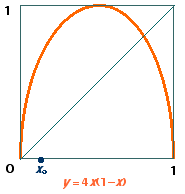 This graph is the parabola
This graph is the parabola
y = 4x(1 – x).
The diagonal blue line has equation
y = x.
In the construction we begin with a point x0 on the x-axis as shown.
The vertical height is then the corresponding y-value, y0 say.
The horizontal line meets the
diagonal y = x giving x1 = y0.
We now continue the process using this x1,
drawing up to the parabola to give the value y1. ...
We thus obtain the recursive sequence of values
x0, x1, x2, ... satisfying xn+1 = 4xn(1 – xn).
Now let us repeat this taking a point close to x0.
Notice how the initial small difference
gives rise to greater and greater variation.